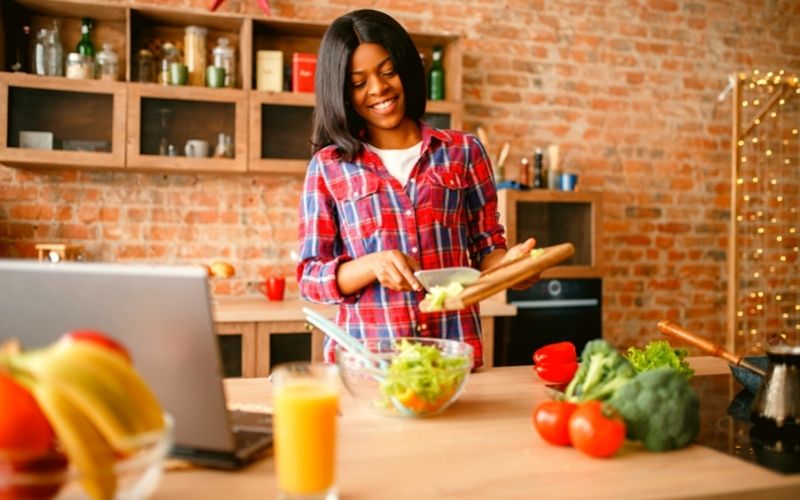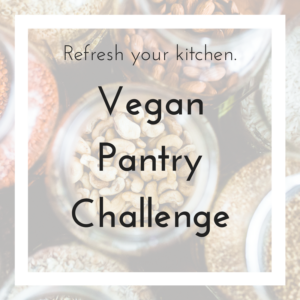Meal kits take the entire mental load and most of the physical load off cooking a meal: you choose your meal from a restricted menu of options, and all the ingredients and directions come to you in a neatly packaged boxed, pre-portioned and ready to be turned into dinner. No wonder they are popular! You get the convenience of prepared and delivered food, with a measure of control over what goes onto your plate, along with the satisfaction of completing a defined set of tasks to achieve a pleasantly edible result. It combines an element of charming surprise (who doesn’t like to get a package in the mail?) and craft-like project that takes you away from your day’s worries, not unlike to the experience offered by coloring books.
You can listen to this blog post on the podcast by clicking “play” below or searching for Vegan Family Kitchen in your favorite podcast app
Everything predisposes me to dislike meal kits as a growing business trend. My mom was a busy farmer, but she was also attended the “Family Institute” for high school and always cooked every dinner from scratch. Prepared meals were just not part of our family culture. As for myself, I pivoted my career away from academic research management to teach vegan cooking, motivated by the urge to do something tangible against environmental degradation. Not only do I cheer for people learning to cook their own plant-based meals, but I also stare at the mountains of packaging waste generated by meal kits with dismay. I admit to often thinking: “Yet another kind of business that preys on our inclination for the convenient and leaves a sea of waste in its wake!”

Does the world really need more food packaging?
Still, even I can see that meal kits do have redeeming qualities. First of all, they provide a healthier alternative to restaurant dishes, which tend to be extra-fatty and super-salty. Second, what they are guilty of when it comes to packaging waste may very well be offset, at least partially, by the likely reduction in food waste that they allow. Third, and perhaps most importantly, they might be a gateway to kitchen independence. People who feel less-than-competent in the kitchen may enhance their feeling of competence (self-efficacy) by successfully using meal kits, paying attention to the instructions, noticing patterns, and eventually venturing into self-catered adventures.
There is room to grow from there.
If you have been a meal kit subscriber for a little while, I would like to invite you to consider the next step: cancel your meal kit subscription and instead subscribe to a meal plan service. Meal plan services allow you to continue outsourcing the mental load of deciding what’s for dinner and breaking it down into manageable steps. The difference will be that you will take on the physical load, procuring groceries and measuring ingredients by yourself. You are already doing a lot of the cooking proper, so that part should not be difficult.
There are two main types of meal planning services to choose from:
- Curated meal planning services harvest thousands of recipes from the Internet, put them in a database, and tag them based on various attributes like common dietary requirements (vegan, dairy-free, gluten-free, etc.), mode of preparation, time of day, etc. They may have modified the recipes to match their style. With varying degrees of human intervention, you receive a weekly meal plan that suits your needs, including the recipes and a compiled shopping list. One well-known omnivorous service is eMeals. The Forks meal planner service from Forks Over Knives and Rich Roll’s Meal Planner are two established plant-based options.
- Hand-made meal plans contain purpose-created recipes designed specifically for the needs of their subscribers. They tend to reflect the style and personality of the lead chef for the service. There may be some level of automated customization. Two examples are Clean Food Dirty Girl’s meal plans by Molly Patrick and her team, and the Vegan Meal Plans by yours truly from Vegan Family Kitchen. In both cases, you get dinner recipes, shopping lists, and prep steps you can take ahead of time (on the weekend) to cut back on weeknight dinner prep time.
In all of the above, customer service is available to answer your questions should you struggle to understand the instructions, find it difficult to secure some of the ingredients, or need to make substitutions due to allergies, for example. I can’t speak for the other services, but I know that I am personally committed to responding to even the most basic questions with love, and as quickly as possible, because I am dedicated to helping more people eat more plants (and fewer animals).
By following the meal plans — mine or others — to cook your own meals, you will further build your confidence and skills while decreasing the amount of both food and packaging waste produced for your sustenance, to say nothing of the money you’ll save. Plus, you’ll learn to customize the plans and recipes to suit your needs, growing into an independent home cook.
Learn more about the Vegan Meal Plans
Go a few steps further by taking the 5,000-Meal Solution course




